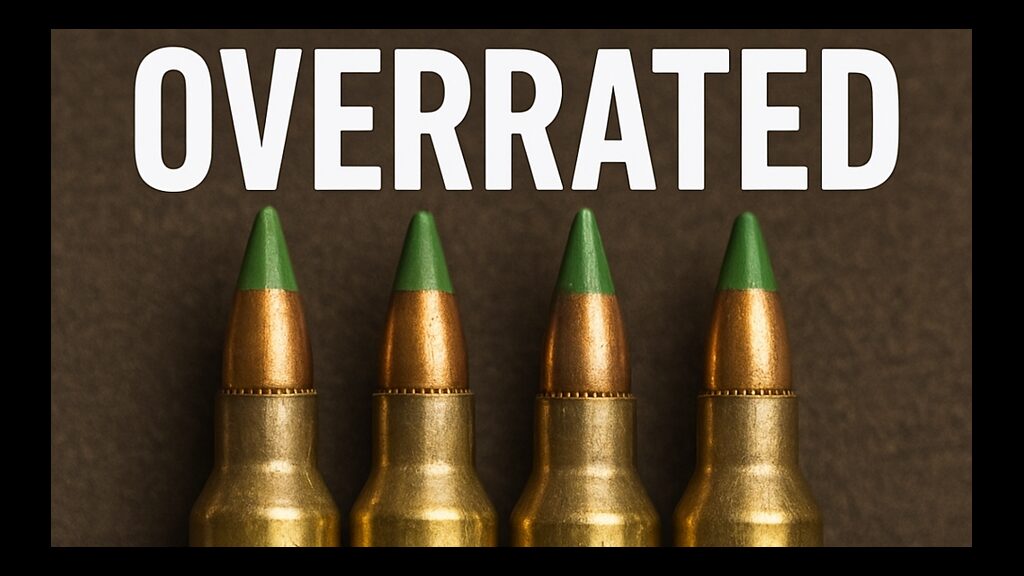If you are into AR15’s, you’ve probably heard about the infamous “green tip” bullets. Many shooters look at the cartridge as your link to a serious, end-of-the-world cartridge with armor piercing capabilities. But under closer observation – especially in the context of real-world use – the M855 turns out to be one of the most overrated 5.56mm NATO cartridges ever fielded.
Let’s talk about it.
M193 vs M855: What Did We Do?
The widely popular M193 is a 55 grain, lead-core FMJ that the original M16 platform was built around. Fired from a 20-inch barrel with a 1:12 twist, the M193 was devastating at close range. Its lighter construction made the bullet yaw and fragment quickly in soft tissue, causing horrific wounds.
During the push for NATO standardization in the 1970s, testing to penetrate Soviet steel helmets at extended range began to take priority over soft targets. NATO eventually settled on the Belgium SS109 in 1980. The SS109 is a lead bullet with a mildly-hardened steel tip that enhanced penetration capabilities and raised the weight of the bullet to 62 grains. The new cartridge entered US service as the M855 as a light armor piercing cartridge, with its now-iconic green tip so it could be distinguished from the M193.
The problem is, the M855 was selected as a result of its ability to pass one test – penetrate a mild steel 3.5mm target at 600 meters, the approximate thickness of a Soviet helmet. But this ability came with a cost of terminal effectiveness.
The M855 is often mistaken as an armor piercing or light armor piercing (LAP) cartridge, but it really is not. The steel tip “penetrator” is really more of a barrier penetrator, helping the cartridge punch light cover. And those same characteristics as a penetrator make it more likely to pass straight through a soft target without significant damage.
Why M855 Performs Poorly
M855’s terminal performance is hampered by the fact that it is a penetrator round, the very feature that defines it: the steel tip. The steel tip was designed to improve performance against helmets and light barriers, but it had two major side effects.
First, it significantly raised the threshold for yaw and reliable expansion. M855 will generally only yaw or fragment reliably when it strikes a target at the right velocity and the right angle. This has become even more challenging with the proliferation of shorter barrels.
The second issue is the steel penetrator reduces bullet deformation. The all lead M193 expands and distorts to transfer more energy into the target. The M855 by contrast largely stays intact resulting in less energy transfer, narrower wound channels, and frequent over-penetration.
As a consequence, the M855 will often, like a needle through fabric, cut a long thin channel causing little actual tissue disruption. Unless it strikes a vital organ or spine, or it hits at the correct angle and speed to yaw, the M855 often is not capable enough to reliably stop an enemy.
Battle of Mogadishu
The Battle of Mogadishu in 1993 (popularized in Black Hawk Down) shined a bright light on the downside of the “green tips”. US forces saw firsthand the failures of the M885 against the unarmored, close-range fighting with the Somali militia.
Retired Delta Force Master Sgt. Paul Howe recount watching Somali militia fighters get hit center mass with M855 – only for the round to pass clean through with minimal effects. The fighters kept moving until hit again, often multiple times. These incidences were not isolated, and several soldiers reported seeing the same thing as Master Sgt Howe saw.
These complaint of “through and through” wounds that began in Somalia continued into the early of Afghanistan and Iraq. Retired Army Chief Warrant Officer Don Alexander (5th Special Forces Group) simply put it, “It just doesn’t do very well at close ranges against smaller-statured people who are lightly equipped and clothed.”
M855 Doesn’t Do It’s One Job Well
The fact remains that M855 doesn’t even work that well for what it was designed to do. When the “green tip” works, the penetrator strikes and penetrates the steel plate, while the soft lead behind the penetrator tends to flow around the tip, widening the impact area instead of focusing it.
While the steel tip is made to penetrate, much can go wrong. The steel tip can readily skid or deflect off the steel, particularly at oblique angles. Additionally, if the lead core deforms unevenly behind it, the penetrator can fail to penetrate.
There is also the important consideration of velocity. With the proliferation of shorter barrels and the M855’s need for speed, adequate velocity is essential for the M855 to perform properly. I think a reasonable argument can be made than under 16” of barrel, the M855 will likely underperform.
By contrast, the M193 – with its lighter 55gr bullet – can pick up speed a bit more efficiently and as a result of simply brute force and density, under certain conditions, beat the M855 at its own game of penetrating steel, despite lacking a penetrator.
It’s Time To Move On
The military has already moved on to the Mk262, Mk318, and M855A1. And you should move on too…
But despite that, don’t count out the M193. It still has a lot going for it; the cartridge is inexpensive, poses no brush fire risk, it is reliable, fragmentation is still quite reliable at close ranges, and it is still fairly tolerant of barrel length.
In short, unless you need to penetrate steel plates from 600 meters away, the M193 will likely be the better choice for you.
Final Thoughts
The M855 got misattributed as an armor piercing round, and the attractive green tip brought along a certain mystique to it. The reality is that the cartridge was never designed to be a best all-around cartridge, it was engineered to win a NATO competition for a very narrow task. It is decent at poking holes in thin steel and not great at everything else – especially from the shorter barrels which most shooters actually use today.
If you are stocking up for a real-world scenario, there are lots of good bullets but I certainly wouldn’t feel bad stocking up on M193.


Leave a Reply